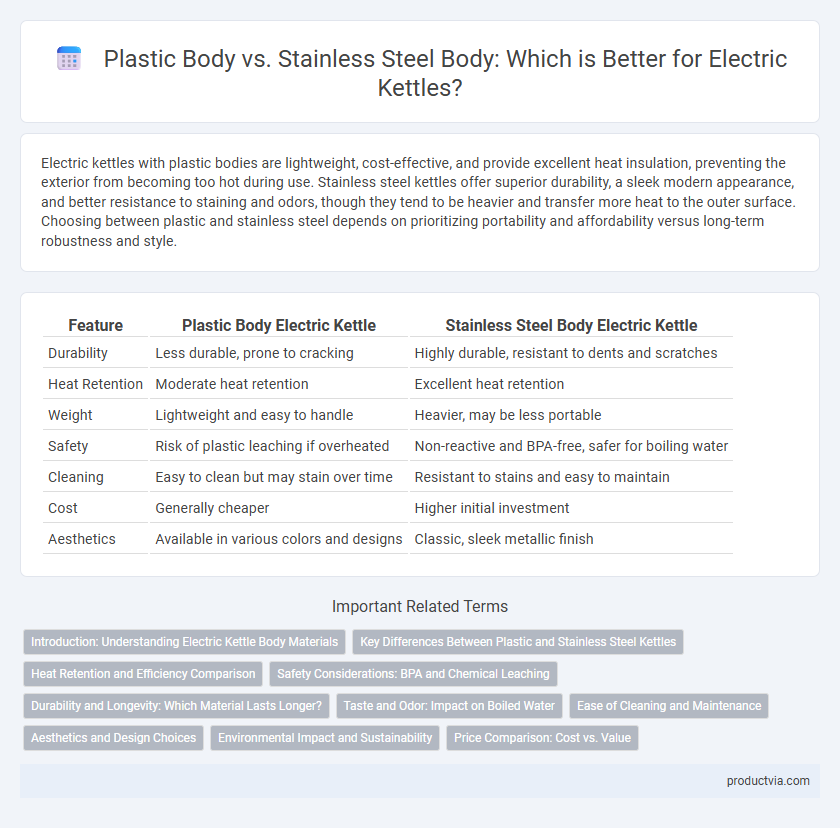Electric kettles with plastic bodies are lightweight, cost-effective, and provide excellent heat insulation, preventing the exterior from becoming too hot during use. Stainless steel kettles offer superior durability, a sleek modern appearance, and better resistance to staining and odors, though they tend to be heavier and transfer more heat to the outer surface. Choosing between plastic and stainless steel depends on prioritizing portability and affordability versus long-term robustness and style.
Table of Comparison
| Feature | Plastic Body Electric Kettle | Stainless Steel Body Electric Kettle |
|---|---|---|
| Durability | Less durable, prone to cracking | Highly durable, resistant to dents and scratches |
| Heat Retention | Moderate heat retention | Excellent heat retention |
| Weight | Lightweight and easy to handle | Heavier, may be less portable |
| Safety | Risk of plastic leaching if overheated | Non-reactive and BPA-free, safer for boiling water |
| Cleaning | Easy to clean but may stain over time | Resistant to stains and easy to maintain |
| Cost | Generally cheaper | Higher initial investment |
| Aesthetics | Available in various colors and designs | Classic, sleek metallic finish |
Introduction: Understanding Electric Kettle Body Materials
Electric kettles commonly feature bodies made from plastic or stainless steel, each offering distinct advantages related to durability, heat retention, and safety. Plastic bodies tend to be lightweight and cool to the touch, making them energy-efficient and safer to handle, while stainless steel bodies provide superior durability, resistance to heat, and a sleek, modern appearance. Understanding the material composition helps consumers choose kettles that best fit their needs regarding temperature control, maintenance, and overall kitchen aesthetics.
Key Differences Between Plastic and Stainless Steel Kettles
Plastic electric kettles are lightweight and typically more affordable, offering good heat insulation that keeps the exterior cooler during use. Stainless steel kettles provide superior durability, faster boiling times due to better heat conduction, and a sleek, modern appearance, but they tend to be heavier and can get hot on the outside. Both materials impact taste and safety, with stainless steel being less prone to retaining odors and free from BPA concerns, unlike some plastics.
Heat Retention and Efficiency Comparison
Stainless steel electric kettles offer superior heat retention due to their dense metal construction, which minimizes heat loss and maintains water temperature longer than plastic bodies. Plastic-bodied kettles heat water quickly but tend to lose heat faster, reducing overall energy efficiency during use. The thermal conductivity of stainless steel enhances heating efficiency, making it a preferred choice for users prioritizing consistent temperature and energy savings.
Safety Considerations: BPA and Chemical Leaching
Electric kettles with stainless steel bodies are preferred for safety due to their resistance to BPA and chemical leaching, unlike certain plastic models that may release harmful substances when heated. BPA, commonly found in some plastic components, poses health risks linked to hormone disruption and should be avoided in kitchen appliances. Stainless steel kettles ensure safer boiling without the risk of toxic chemicals contaminating water, making them a healthier choice for everyday use.
Durability and Longevity: Which Material Lasts Longer?
Stainless steel electric kettles offer superior durability and longer lifespan compared to plastic-bodied models due to their resistance to heat, corrosion, and physical impact. Plastic kettles may degrade over time with repeated heating cycles, leading to cracks or discoloration. For long-term use, stainless steel remains the preferred choice for longevity and sustained performance.
Taste and Odor: Impact on Boiled Water
Plastic-bodied electric kettles can sometimes impart a slight plastic taste or odor to boiled water, especially when new or heated repeatedly at high temperatures. Stainless steel bodies provide a neutral surface that does not affect the water's flavor or smell, making them ideal for taste-sensitive users. Opting for stainless steel ensures cleaner, fresher-tasting water without chemical aftertastes.
Ease of Cleaning and Maintenance
Electric kettles with stainless steel bodies offer superior ease of cleaning compared to plastic ones due to their smooth, non-porous surface that resists stains and odors. Stainless steel is more durable, allowing for vigorous scrubbing without damage, while plastic bodies can retain discoloration and absorb odors over time, complicating maintenance. Regular descaling is essential for both materials, but stainless steel kettles typically require less frequent cleaning to maintain their appearance and hygiene.
Aesthetics and Design Choices
Plastic-bodied electric kettles offer lightweight construction and diverse color options, enhancing playful and contemporary kitchen aesthetics. Stainless steel bodies provide a sleek, modern appearance with a polished or brushed finish, contributing to a premium and durable design appeal. Design choices often depend on kitchen decor style, with plastic favored for casual, vibrant spaces and stainless steel preferred for minimalist, professional environments.
Environmental Impact and Sustainability
Plastic-bodied electric kettles generally have a lower upfront carbon footprint due to energy-efficient manufacturing but pose challenges in recyclability and contribute to plastic waste pollution. In contrast, stainless steel kettles offer enhanced durability and recyclability, reducing environmental impact over their lifecycle by minimizing landfill accumulation and promoting circular material use. Prioritizing stainless steel promotes long-term sustainability through resource conservation and decreased toxic plastic leachates.
Price Comparison: Cost vs. Value
Plastic-bodied electric kettles generally offer a lower upfront cost, making them an attractive option for budget-conscious consumers. Stainless steel models, while typically priced higher, provide enhanced durability, better heat retention, and often contribute to a longer lifespan, delivering greater long-term value. Evaluating price against benefits such as material longevity and aesthetic appeal highlights that stainless steel kettles justify their premium through cost-per-use efficiency and overall performance.
Plastic body vs stainless steel body for electric kettles Infographic

 productvia.com
productvia.com